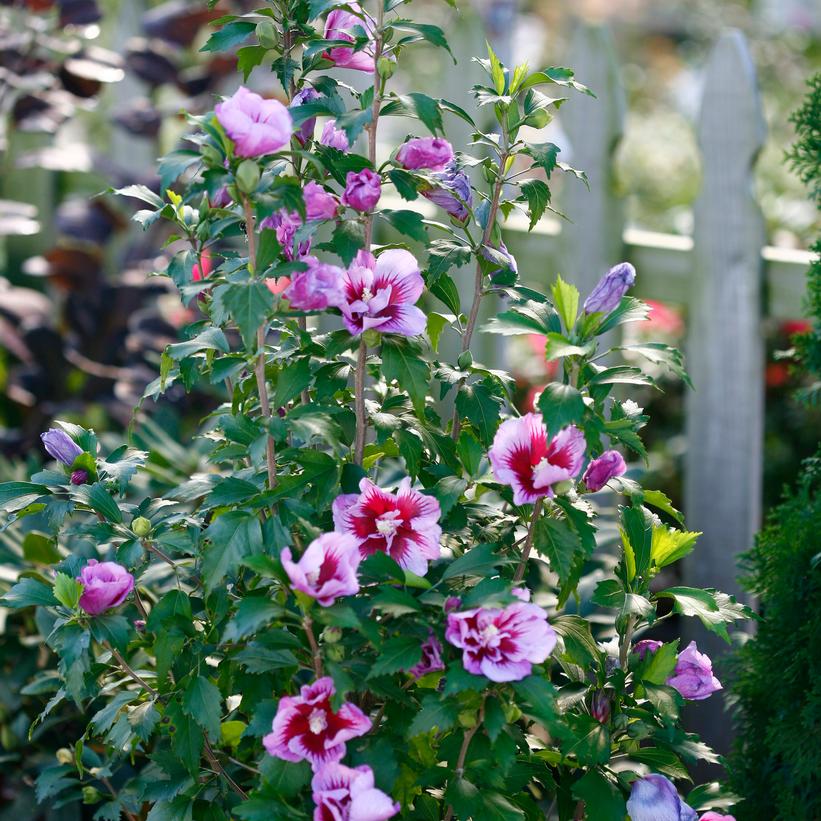Common Name: Purple Pillar Rose of Sharon
Bloom Time: Mid to late summer (July–September)
USDA Zones: 5–9
Mature Size: 10–16 ft tall, 4–5 ft wide
Introduction
In the midsummer garden, when many perennials have finished flowering, the Purple Pillar® Hibiscus bursts to life with richly colored blooms that delight both gardeners and pollinators. Unlike the traditional mounded habit of most Rose of Sharon selections, Purple Pillar® grows upright in a tight column, making it an ideal choice for narrow spaces, privacy screens, or as an architectural focal point. This Plant Spotlight explores its origins, cultural requirements, care guidelines, and landscape uses, offering everything you need to know to integrate this striking shrub into your South East Wisconsin garden.
Origins and Description
Purple Pillar® was introduced by Proven Winners as a standout selection of Hibiscus syriacus, a deciduous shrub native to East Asia and long cultivated in European cottage gardens. The cultivar ‘Gandini Santiago’ was selected for its unique growth habit: multiple strong stems rise vertically, forming a densely branched, narrow column studded with large, five-petaled flowers. Each bloom features a violet-purple outer edge blending into a deep crimson eye, creating a dramatic, two-toned effect that persists over a long flowering period. Leaves are glossy green, three-lobed, and arranged alternately along slender stems.
Ideal Growing Conditions
Light
Full sun is essential—aim for at least six to eight hours of direct sunlight daily. In our South East Wisconsin summers, this ensures robust flowering and helps prevent leggy growth.
Soil
Purple Pillar® thrives in moist, well-drained soils. While adaptable to a range of soil textures from sandy loam to silty clay, amending heavy soils with compost or aged bark will improve drainage and root vigor.
Hardiness
Rated for USDA Zones 5–9, this hibiscus tolerates Wisconsin’s winter lows (down to –20 °F) once established. Spring pruning and a layer of mulch around the root zone will safeguard new shoots from late frost.
Planting and Establishment
-
Timing: Plant in spring after the last frost or in early fall at least six weeks before the first expected freeze.
-
Site Preparation: Dig a hole twice the width of the root ball but no deeper than its depth. Amend the backfill soil with compost (no more than 25% by volume).
-
Planting: Position the root crown level with the surrounding soil. Backfill, gently firming to remove air pockets, and water deeply.
-
Mulching: Apply a 2–3″ layer of hardwood mulch, keeping it an inch away from the stem to prevent crown rot.
During the first growing season, provide regular watering—approximately 1″ per week—especially during dry spells. A balanced, slow-release fertilizer applied in early spring encourages lush foliage and abundant blooms.
Care and Maintenance
-
Watering: Once established (after one full growing season), Purple Pillar® is moderately drought-tolerant but performs best with consistent moisture.
-
Fertilization: Use a general-purpose shrub fertilizer in early April and again in midsummer. Avoid high-nitrogen formulas, which can promote excessive leaf growth at the expense of flowers.
-
Deadheading: Removing spent blooms is optional; H. syriacus sets flowers on new wood, so deadheading won’t reduce flowering and only improves tidiness.
Pruning and Propagation
Pruning
Late winter or very early spring—before bud swell—is the ideal time to prune. To maintain its columnar form:
-
Remove any dead or crossing branches at the base.
-
Thin out the oldest stems (older than three years) by cutting them to ground level to encourage new, vigorous shoots.
-
Shorten overly tall stems by one-third to maintain overall shape and prevent wind damage.
Propagation
While Purple Pillar® can be propagated by softwood cuttings in late spring, most gardeners prefer purchasing container-grown liners to ensure true-to-type performance.
Landscape Uses and Companions
-
Privacy Screens: Line several specimens 4–5′ apart for a slender hedge that blooms spectacularly in summer.
-
Accent Specimen: Place near entries, patios, or along walkways to create a vertical pop of color.
-
Container Planting: Its upright habit suits large containers—pair with trailing annuals at the base for seasonal interest.
-
Companion Plants: Combine with late-summer bloomers like ornamental grasses (e.g., Miscanthus sinensis), late-flowering spirea (Spiraea japonica ‘Little Princess’), or sedum (Sedum ‘Autumn Joy’) for a tapestry of texture and color.
Conclusion
Purple Pillar® Hibiscus brings a rare combination of form and color to the summer garden—perfect for gardeners seeking vertical accents without sacrificing bloom power. Its narrow habit, winter hardiness, and long flowering season make it a versatile addition to Southeast Wisconsin landscapes.

